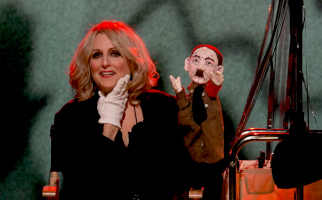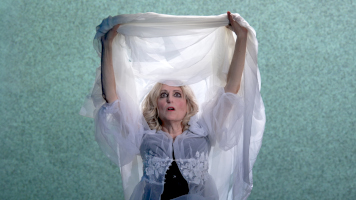
|
Beate Hein Bennett
A Life in Kaleidoscopic Exposure May 29 –June 14, 2025
To compress the long complex life of Leni Riefenstahl (1902-2003), one of the most revolutionary film makers and controversial personalities of the 20th century into a brief 80 minutes takes a thought-experiment sort of approach. The playwright Gil Kofman did that with an imagined post-mortem Leni Riefenstahl who rallies all her seductive manipulative powers to present fragments of her life as an artist while justifying her choices as a human being. The sum total impression is that of a woman whose passionate single-minded pursuit of her art as a film- maker glosses over her deeply flawed and fractured character.
Leni Riefenstahl was spectacular as a personality: she was beautiful and, being a trained dancer and actress, she moved with the athletic grace of a cat. As a film-director, she revolutionized the medium by moving the camera into positions that would heighten and control the aesthetic experience, thus giving the audience a sense of sharing moments of power and intimacy. She caught the eye of Hitler and his propaganda minister Goebbels very early in her career and was asked to document the Nazi Party rally in Nuremberg in 1934. This resulted in her most famous film “Triumph of the Will” (1935) an exemplary study in the seduction of power. In 1936 she followed it with “Olympia,” her documentary of the 1936 Berlin Olympic Games; it is a paean on the beauty of the athlete’s moving body, meant to celebrate the superiority of the white “Aryan” race but with the surprise win of the beautiful black body of the American Jesse Owen. In the early stages of World War II, she made other propaganda films for the Nazi regime, even using extras (Jews and Romas) that would be subsequently killed in Auschwitz, e.g. “Lowlands.” When she was in her 90s she went to Sudan to film rituals of the Nuba tribe, again focusing on the physical beauty of the Nuba. There her European fascination with exoticism is apparent-- what Edward Said described as the Orientalist view, a kind of idealizing colonial attitude towards then called ‘primitive’ populations. In all her films, she celebrated power and beauty as a unified force with what Susan Sontag analyzed as “fascist aesthetics.” She never could bring herself to come to terms with her collaboration with the Nazi machinery and would angrily reject any kind of culpability, claiming ignorance of the horrors of the Holocaust—a frequent post-war attitude of Germans of her generation. Many of her co-workers and later interviewers noted that she seemed to lack empathy—she was all aesthetic Artist and edited out what did not fit!
Gil Kofman’s script demands a difficult task of an actress and the audience: to enact and to follow a brilliant but relentlessly unsavory character. Her narcissistic persona displays a certain amount of self-deprecating humor, and the title “Leni’s Last Lament” is ironic given that she ‘laments’ her being publicly hounded for her past which she sees as an artistic success story. Director Richard Caliban and lighting/projection designer Joey Moro create a suitable visual setting with cold white sculptural lighting and projections, some from historical footage. Film posters from the20s and 30s surround the stage, thin film strips of various lengths are suspended from the ceiling, and a director’s chair sits off to the side, two clothes racks hung with more film strips, and bins containing props complete the setting in the intimate space of the Paradise Factory (an apropos space metaphor for films). Musician Spiff Wiegand improvises on accordion, clarinet, or violin creating the rhythmic beats and undercurrents, sometimes in front of the projection screen sometimes behind it, thus intimating the importance of rhythm in Riefenstahl’s films.
Jodie Markell embodies Leni Riefenstahl as the aged blond would-be-sexy icon, dressed in a black corseted short outfit. (The actual young Leni was a dark-haired beauty, mostly dressed in pants or a proper dress; the aging ‘blond’ Leni wore more extravagant fashions.) Ms. Markell is a powerhouse of an actress who brings out all the cunning seductive aspects of the character as well as her awkward stumbles over historical facts that she will not or cannot face. Only at the very end do the author and the director give her the (almost) redeeming apotheosis—it is a beautifully crafted moment—she is a creature of artifice, as much a product of her own imagination as her films are. And from her tomb, she raises a question for us: Would we be able to follow our own better angels and withstand the illusory seduction of beauty, power, and influence, whether as artists or as simple human beings? It is a very timely question to ask. A note of interest: Leni Riefenstahl has apparently become again a figure of interest. In May 2025, a documentary film, “Leni Riefenstahl: The Horrible Power of Images” has just been released in the UK and is being shown in a German film festival in Australia but not yet in the US. Meanwhile you can ponder the serious ethical questions raised by “Leni’s Last Lament” presently playing at Paradise Factory. |
| recordings | coupons | publications | classified |




